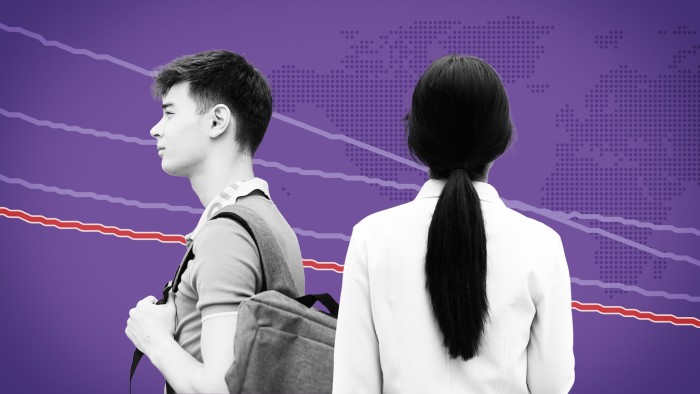EH Seo was born and raised in South Korea’s southern port city of Busan, but never doubted she would study and work elsewhere.
“Not only my parents, but everyone’s parents wanted their kids to move to Seoul,” said Seo, 32, who left South Korea’s second-largest city straight after high school and now works in the capital. “I wanted to go too, and I have no regrets.”
For most of the 20th century, Busan was a thriving hub of trade and industry. But the city is now in the throes of an exodus of the young that has left it ageing faster than any other metropolitan area in a country that already has the lowest fertility rate in the world.
Located on the south-east tip of the Korean peninsula just across from Japan, Busan’s fortunes have worsened since the 1990s as local industries suffer from South Korea’s transition into a high-tech industrial economy.
The Korea Employment Information Service, a government agency, last year officially classified Busan as “at risk of extinction” — when the imbalance between the working and non-working populations makes a city economically unsustainable.
The city of 3.3mn shed 600,000 people between 1995 and 2023. Demographers warn this trend is accelerating as the city’s population ages and Seoul tightens its grip over the country’s economy.
Busan retains both charms and assets — mountains and beaches, temples and nightlife, famous film and art festivals and proximity both to Japan and to industrial centres clustered along South Korea’s east coast.
While it was the birthplace of leading conglomerates Samsung and LG, not one of South Korea’s 100 largest companies is headquartered in the city.
“The outflow of young people is getting larger,” said Seo. “Every time I go back, I can see it losing its vitality.”
Busan boomed in the second half of the 19th century because of its proximity to Japan — a bridgehead first for Japanese trade and investment and later for colonisation.
Japanese industrialists set up factories in Busan producing cheap goods ranging from rubber and shoes to wood. After Tokyo’s defeat in the second world war, the factories were taken over by Koreans and Busan received a surge of returnees from Japan.
North Korea’s 1950 invasion prompted a second wave of arrivals after the South Korean government temporarily retreated from Seoul to Busan. Between 1945 and 1951, the city’s population grew from 280,000 to 840,000.

Busan benefited from a “national development strategy” in the 1960s and 70s that built an industrial corridor between it and Seoul, with Busan’s port serving as the main trading hub for a booming export-oriented economy.
But the city’s fortunes turned as South Korea moved beyond the production of cheap consumer goods in which Busan’s factories specialised.
A Korean economy increasingly powered by the production and export of more sophisticated goods was exemplified by Samsung Electronics’ semiconductor fabrication plants on the outskirts of Seoul.
Universities and research institutes migrated to meet the demand for skilled workers. The port of Incheon on the west coast — closer to Seoul, and more convenient for trading with China — supplanted Busan as the country’s leading export hub.
“Successive governments pursued a policy of national centralisation as a way of maximising efficiency to compete with Japan and China,” said Busan’s deputy mayor Lee Jun-seung. “We got left behind.”

Lee Sang-ho, a researcher at the government employment information service, known as KEIS, said centralisation had pushed Busan and other South Korean regional economic centres into a “chain reaction of decline” exacerbated by intensifying competition from China.
“Most of the major provincial cities outside the metropolitan area in the country are experiencing a similar phenomenon,” Lee said. “Rural areas with small populations were the first to be hit, followed by small and medium-sized cities, and now it is hitting metropolitan areas like Busan.”
He added that while many young men from Busan could still find manufacturing jobs in other industrial hubs in the south-east, women were more likely to have to go to Seoul to find service sector work.
Local civic groups argue that the city’s decline has been exacerbated by local government mismanagement.
The Baby Gap

This is the fourth article in a series on the looming global demographic crisis as population levels are set to shrink
Part 1: Politicians want more children but their policies are falling short
Part 2: Kenya — a window into Africa’s demographic future
Part 3: The country that migration left behind
Part 4: South Korea’s second city fears demographic disaster
Lee Seung-han, secretary-general of Busan civic group Social Welfare Solidarity, said that instead of identifying new growth areas for the local economy in the 1990s, successive mayors sold public land on the outskirts of the city to developers. The sales fed a real estate boom fuelled by money from foreigners buying luxury waterfront apartments as investments.
The result, Lee said, was to benefit older property owners at the expense of young residents not yet on the housing ladder, widening a generational wealth gap and making it even harder for young people to live in the city.
“They acted more like property developers than mayors,” said Lee. “Busan literally means ‘many mountains’, but now we call it ‘the city of many apartments’ instead.”
Lee Sang-ho of KEIS noted that the Busan beach resort suburb of Haeundae, which was developed as part of the 1990s real estate boom and is known as the “Copacabana of Korea”, is one of the wards of the city highest on the extinction risk index. The index is based on the ratio of female residents aged between 20 and 39 and the population aged 65 or over.
“[Haeundae] is a place where high-rises are clustered, but young people cannot afford to live there,” Lee said. “The majority of local people live behind the high-rises in undeveloped areas, as the city becomes increasingly polarised.”
But deputy mayor Lee Jun-seung said that in the 1980s and 1990s the city’s main problem had been a shortage of housing, industrial land and proper transport links.
Observers note that even Seoul, which has sucked in young people from all over the country, is facing a demographic crisis of its own as they respond to the brutal competition for well-paid jobs and education by opting out of marriage and parenthood.


At 0.72, South Korea’s fertility rate — the average number of children a woman is expected to give birth to in her lifetime — was in 2023 the lowest in the world. But despite attracting young people from all over the country, Seoul’s fertility rate in 2023 was even lower — at 0.55. The OECD considers a fertility rate of 2.1 to be necessary to ensure a broadly stable population.
“While Busan’s population is expected to decrease by 33.57 per cent between 2020 and 2050, Seoul’s population is expected to decrease by 21.45 per cent over the same period,” said Kim Se-hyun head of the Population Impact Assessment Center at the Busan Development Institute.
“The difference is that in Busan, there will be a far bigger decrease in the working-age population as a proportion of the population as a whole,” said Kim, adding that despite the decline, the city’s risk of literal “extinction” remained extremely remote.
Economists say the decline of regional economies is all the more stark because South Korea’s centralised model no longer appears to be delivering the kind of headline GDP growth required to mitigate the effects of the country’s demographic crisis.
The Bank of Korea has slashed the country’s GDP growth projection for 2025 to 1.6-1.7 per cent, down from a projection of 2.3 per cent less than a year earlier.
Central bank governor Rhee Chang-yong told the Financial Times last year that “drastic solutions” including a cap on university admissions from Seoul’s most upmarket neighbourhoods were required to encourage people to leave Seoul and return to provincial areas.


Busan’s deputy mayor Lee Jun-seung said the city needed more autonomy, including the devolution of financial sector regulatory powers to attract skilled young workers.
He also said immigration was “crucial”, outlining plans for special regional visas for students and skilled workers from south-east Asia.
But Lee Sang-ho of KEIS said that without fixing the underlying problem of unbalanced regional development, immigrants would — like locals — end up simply moving to Seoul.
The country’s political class, still distracted by the fallout from president Yoon Suk Yeol’s botched martial law declaration in December, has shown little sign of being capable of delivering a deep-rooted restructuring of the country’s flagging economy.
In the meantime, Busanites such as Yang Mi-sook, the leader of local citizens’ campaign group, lament the city’s decline as thousands continue to leave each month.
“It is so sad and frustrating,” she said. “The government should admit that we have a serious problem — after all, with no citizens left we will have no need for politicians either.”










